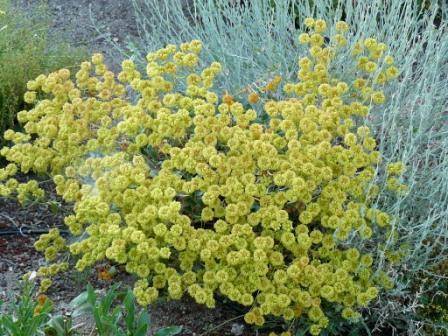Sulphur Buckwheat in the Landscape

Diane Jones, Draggin' Wing Farm, Water-thrifty Plants for Idaho
Scientfic Name: Eriogonum umbellatumCommon Name: Sulfur Buckwheat, Sulfurflower Buckwheat, Umbrella Desert Buckwheat
Description: Sulfur-yellow ball-like flower stalks over a woody base of leathery, oval leaves.
Native Habitat: Widespread and highly variable throughout the arid Intermountain West from sagebrush deserts to alpine rocky ridges from 4,000 to above 10,000. Very cold hardy.
Cultural Requirement
Soil: Tolerant of a range of soil types; grows well in poor, rocky soil or garden loam.
Moisture Tolerance: Extremely xeric.
Sun/Shade/Preference: Full sun.
Transplanting: Transplants well from containers; do not attempt to dig plants in the wild.
Propagation: Seed.
Maintenance (pruning, fertilization, deadheading, division, irrigation, etc): No maintenance necessary. Spent flower stalks may be removed in the spring.
Insect, disease, or other problems: None of concern.
Landscape Value
Use in the Landscape: Dark mound of semi-evergreen foliage is attractive in and out of bloom. Highly valuable, underused landscape plant; flowers are nice in dried flower arrangements.
Foliage: Spoon-shaped, dark green, leathery leaves.
Flower: Sulfur pom-poms fade orange, copper or even red after blooming. They remain attractive in the landscape, so deadheading is not necessary.
Timing: Early - Mid-summer.
Color: Various shade of yellow from pale to deep sulfur.
Form: Low, mounding, semi-evergreen
Texture: Woody, leathery
Ultimate Size: Base is 4"-6" tall x 12" 24" wide; flowering stalks may reach 24" or more
Rate of Growth: Moderate growth with supplemental water
Suggested Plant Partners: Sagebrush, Rabbitbrush, Woolly Sunflower
Availability: Available at specialty nurseries
Cultivars: Over 30 recognized varieties, including a few named ones: ‘Kannah Creek", "Shasta", and "Sierra"
References:
Taylor, Ronald, Sagebrush Country, A Wildflower Sanctuary, Mountain Press, 1992, p. 30.
Parkinson, Hilary et. al., Landscaping with Native Plants of the Intermountain Region, U.S. B.L.M. Technical Reference #1730-3, 2003, p. 6.
Blackwell, Laird R., Great Basin Wildflowers, Morris, 2006, p. 163.
Meyer, Susan et. al., Landscaping on the New Frontier, Waterwise Design for the Intermountain West, Utah State University Press, Logan, 2009, p. 174.
Mee, Wendy et. al. Waterwise, Native Plants for Intermountain Landscapes, Utah State University Press, Logan 2003, p. 117.
Earle, A. Scott, Idaho Mountain Wildflowers, Larkspur, 2001, p.118.

